How to use
- Gather the supplies
- Indwelling Foley Catheter Tray with a 10-cc balloon. The tray comes with all the needed supplies. Size 16fr is a common size used for adults.
- Syringe to deflate the balloon of the existing catheter, if there is one already in the bladder.
- Soapy wash cloth and wet wash cloth.
- Wash hands with soap and water.
- Prepare all needed supplies.
- Lie flat on back with legs flat.
- If there is already a catheter in place, remove it by deflating the balloon, which is what holds the catheter in place inside the bladder.
- Attach the syringe to the end of the “Y” pigtail, or side port.
- Withdraw the plunger of the syringe. This will deflate the balloon on the catheter inside the bladder.
- You will know it is completely deflated when you are unable to pull any more water into the syringe.
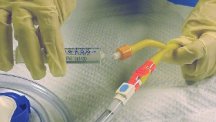
- Gently pull the catheter out from the bladder.
- Wash urinary opening with the soapy cloth and rinse with the wet cloth. Dry well.
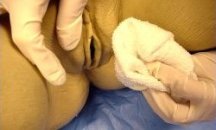
- Wash hands again.
- Open the indwelling catheter tray carefully. Set up the supplies.
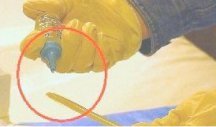
- Place paper pad under hips.
- Put on the gloves if this is not a self-catheterization.
- Pour the betadine onto the cotton balls.
- Remove the plastic cover from the catheter, being careful not to touch the catheter tube, and squirt the lubricating jelly onto the catheter.
- Remove the rubber cap from the syringe with the water in it.
- Connect the end of the catheter to the drainage bag.
- Choose your “clean” and “dirty” hand. The hand that comes in contact with the body, the one that holds the labia, is considered the dirty hand. The hand that touches the catheter supplies is considered the clean hand. Never mix clean and dirty hands in regard to the catheter supplies. It is important that this procedure stay very clean so as not to allow germs to enter the bladder.
- Using one hand, spread the labia open so you can find the urinary opening. This hand is now your “dirty” hand. Do not use it to touch supplies in the kit.
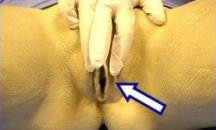
- Clean urinary opening.
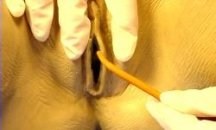
- Use clean hand to touch items in the kit.
- Clean urinary area with the cotton balls soaked in Betadine.
- Use one cotton ball per wipe.
- Always wipe from the top of the area towards the bottom.
- Never reuse a cotton ball.
- Insert the catheter slowly and gently into the urinary opening
- See the urine flow into the catheter. Continue to insert the catheter slowly for another 2 inches.
- Blow up the balloon.
- While holding the catheter in place, attach the pre-filled syringe in the kit to the “Y” pigtail port and insert all of the water from the syringe.

- If it is easier, you can attach the syringe before you insert the catheter, so it is ready when you need it. Do not blow up the balloon until the catheter is in and you see urine flowing. Never blow up the balloon until you see flowing urine inside the catheter.
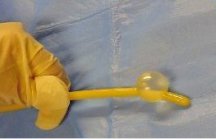
- Wash off the extra Betadine from the urinary area.
- Always hang or attach the drainage bag to chair or bed frame below the level of the bladder. This will allow for the best drainage.
- Consider wearing a leg strap. The leg strap attaches the catheter to the inner thigh. It helps to keep the catheter secure.
- If wearing a leg bag, always wear it below the knee.
- Clean around the catheter and urethra daily.
- Use unscented antibacterial soap and water.
- Dry the area carefully.
- Wash area after each bowel movement.
Common questions
How often does the catheter need to be changed?
Catheters can stay in for about a month as long as it is not leaking or having crusty areas around it near the urethral opening. You should wash the urinary opening at least twice a day while the catheter is in place. Change the catheter by the schedule given to you by your doctor.
Should I save anything from the catheter kit in case problems arise with the catheter?
Yes. Save the syringe so you can deflate the balloon when the catheter needs to be removed.
What if touch the catheter with my dirty hand or I drop the catheter on the floor before I have it safely inserted?
Stop and get another catheter or kit. It is important that germs do not enter the bladder during this procedure.
What if I have spasms while the catheter is being inserted?
Stop and wait for the spasm to pass; then continue with the insertion.
What if the catheter will not go in easily or I feel like I meet resistance when inserting it?
Do not force the catheter in. Call the doctor for further advice.
What if I accidentally insert the catheter into the vagina instead of the urethra?
Start over and use a new kit. Don’t feel bad. Sometimes this happens.







